前言
科普界的老问题了。
大部分博客日志抄官方文档给的初始化样例,啥也不说。
看完除了会create,啥也不会了。
自食其力研究一下。
创建
略。
见document。
https://learning.postman.com/docs/designing-and-developing-your-api/mocking-data/mocking-with-examples/
或者随便找个中文博客。
推荐 https://zhuanlan.zhihu.com/p/371127186
但这篇文章的部分说法有误
比如文中称"Mock server只会采用最后创建的example"。 这是不对的。Mock Server会按规则匹配对应example。
创建之后,通过copy URL可以得到这个mock server的链接
默认作为公链
逻辑
postman逻辑结构有4层.
collection / folder / request / example
其中request是基本单位, 对应 http请求的寻址.
其实还有一个env,不过对这篇文章来说不重要。
1. request寻址
举例, 有一个http请求如下
axios.request(
{url:'/api'}
)
则需要对应地在postman中构建一个同地址的request.
{{url}}/api
值得注意的是, request中的地址部分, 前缀固定为"{{url}}"表示占位符.
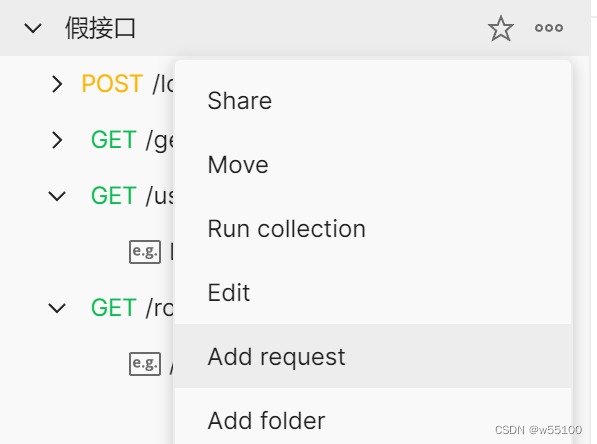

此处输入 {{url}}/api 即可. 记得save.

最上面那个requestName = "New Request"可改可不改,就这样放着叫new request也无妨。
这个name是仅供postman使用者自己理解用的。
寻址是根据我们填写的url来的。
这样我们约定了一个地址为’/api’ 的接口。
接下来需要约定返回的数据。
2. example数据响应
request本身不能设置response data, 但example可以设置响应数据。
一个request下,可以添加多个example。
postman会根据http请求的不同,自动匹配对应的example,
然后返回该example中的response。
默认情况下,我们应该添加一个名为"Default"的example.
这个是缺省名字, 就像 index.html , __init__.py 之类的一样.
这样写是符合规范的。
下面演示区别
我新建了一个New Request, 设置地址为
{{url}}/login
之后添加两个example, 分别命名为"Default" 和 “login”.
在"Default"中,我约定接口的方法是"POST", 返回值写"postlogin".
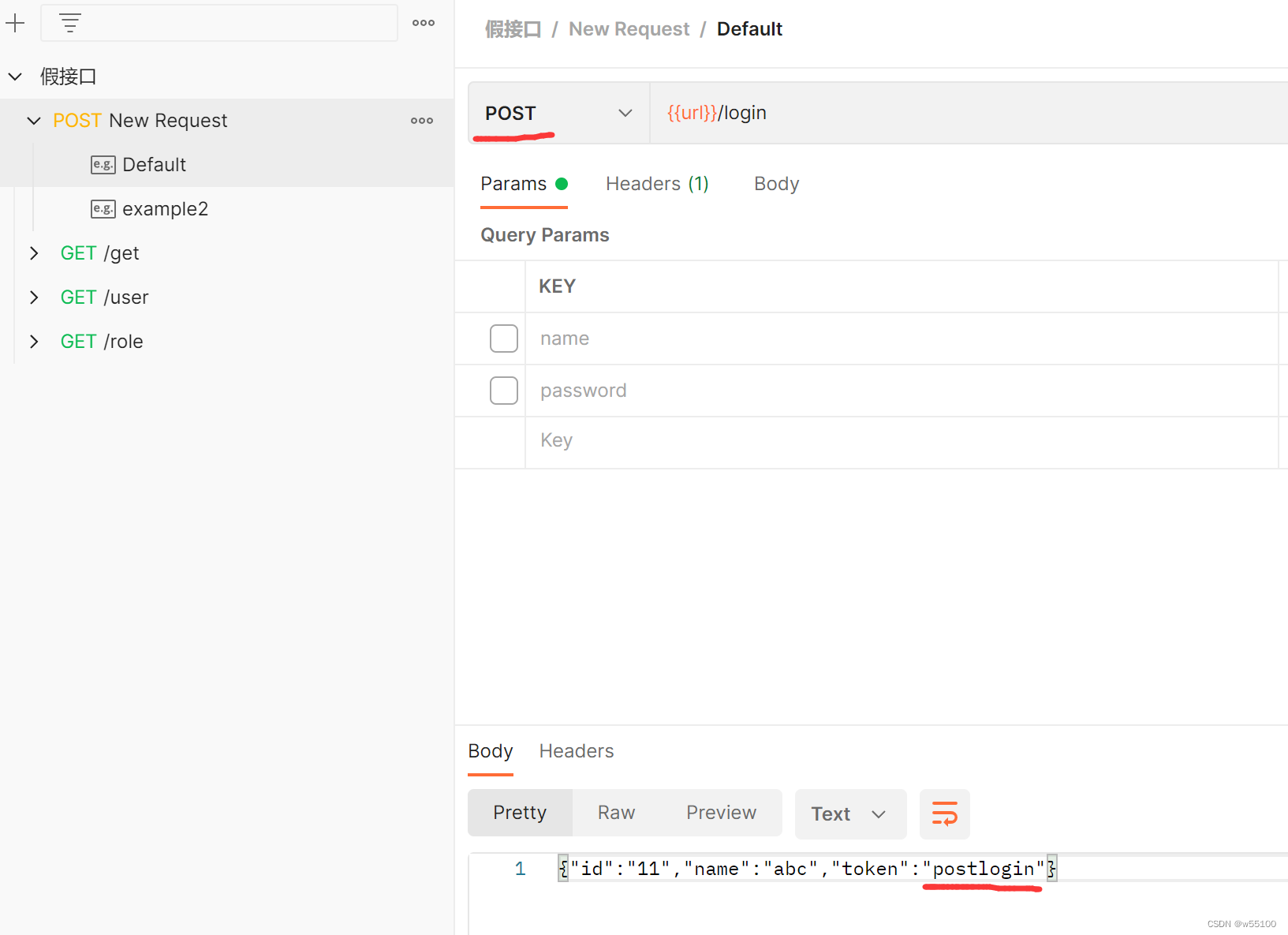
在"example2"中, 约定接口方法为"GET", 返回值 “getlogin”。
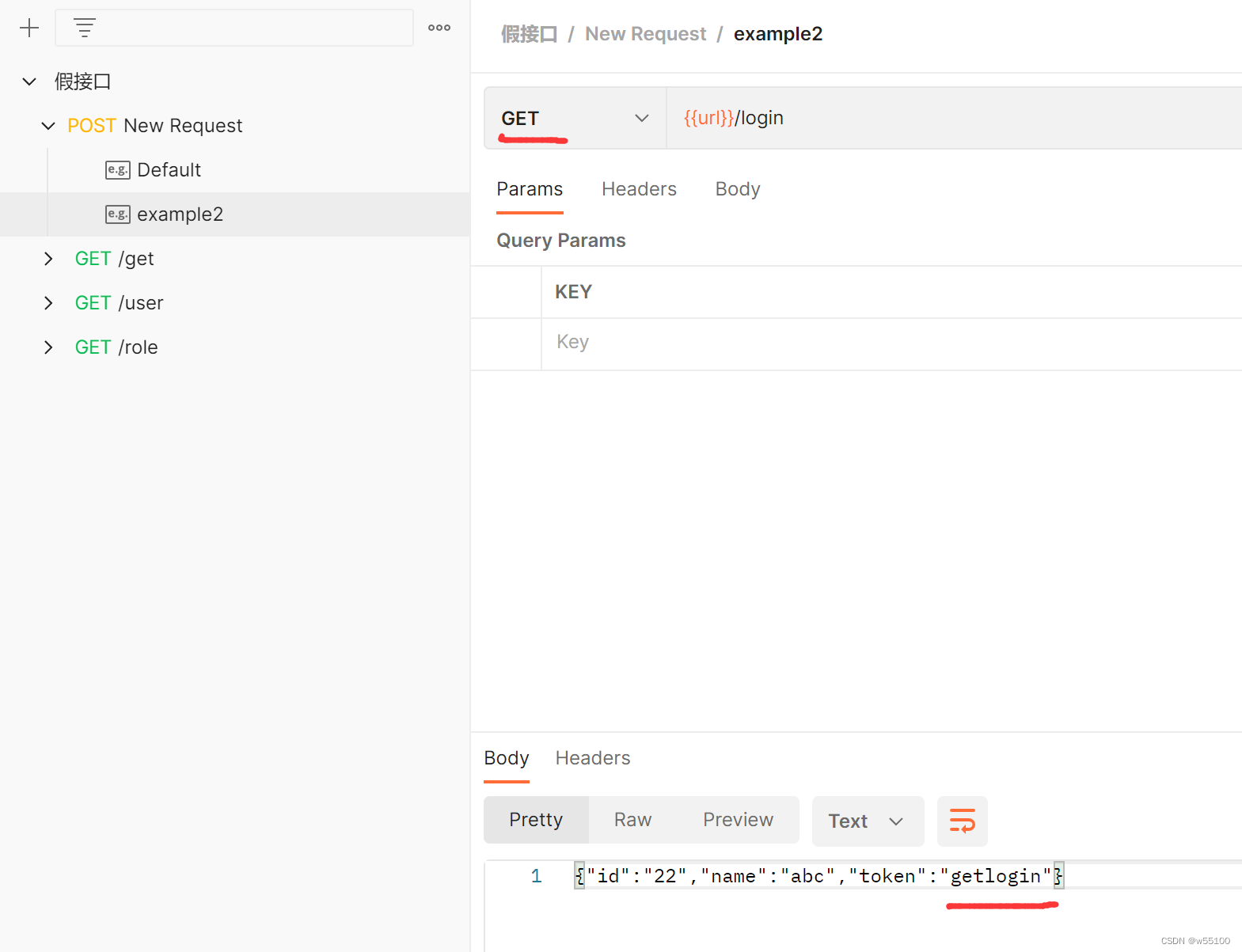
分别发送请求
axios.get({
url:'/login'
}).then((res) => {
console.log(res.data)
})
axios.post({
url:'/login'
}).then((res) => {
console.log(res.data)
})
可以看到非常良好地匹配上了两个example。

除了method以外, 还能匹配http response code等.
postman的匹配算法说明
https://learning.postman.com/docs/designing-and-developing-your-api/mocking-data/matching-algorithm/
3.数据动态响应
postman可以通过占位符传参。
最经典的param传参就是我们很常见的 问号后面跟key:value对的形式。
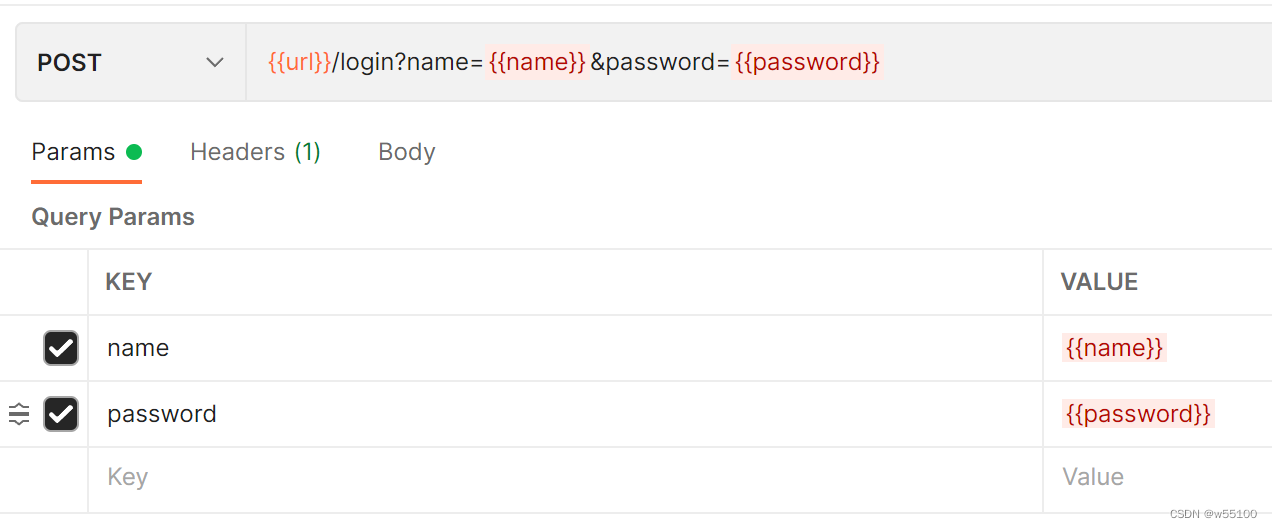
但要注意的是,这种传参方式在postman中的原理,本质上只是 传一个urlString, 通过匹配占位符的方式, 为变量赋值。
所以我们可以写得更暴力一点,连key都不需要了, 毕竟在解析环节用不上。
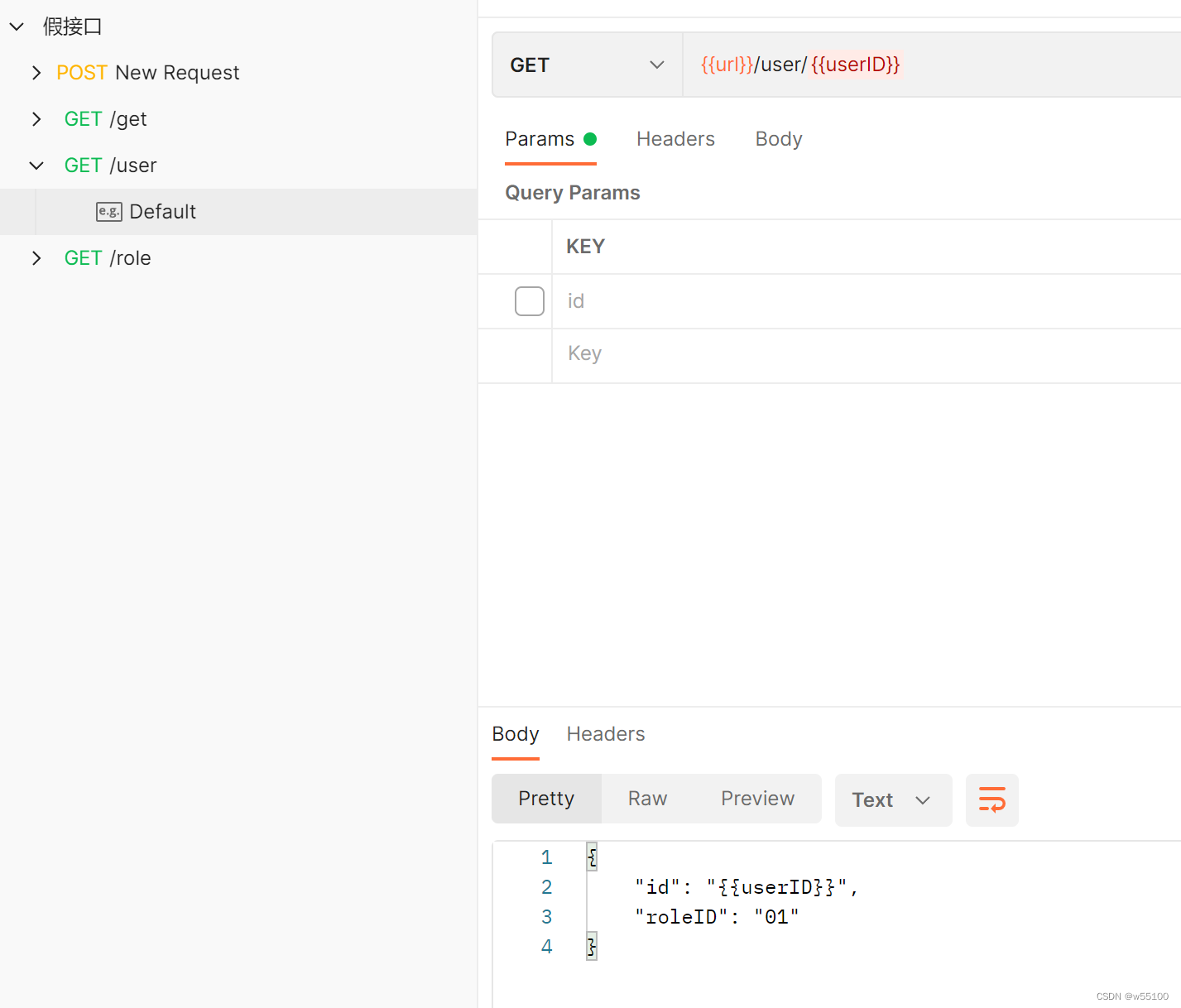
这里需要注意的是,在response Body部分,
也是会经过mustache语法匹配,将"{{userID}}"部分替换为相应变量值的字符串 。
可以写更复杂的逻辑, 取到userID之后再做点别的处理。
不过对于一个仅供测试的mock server来说, 能满足基本的动态响应应该足够了。
数据底层
先去https://web.postman.co/settings/me/api-keys
创建一个api-key.
然后新建一个request.
headers里面写上 x-api-key

url填
https://api.getpostman.com/collections/
请求之后,在response里找到自己的mock name,和对应的uid.
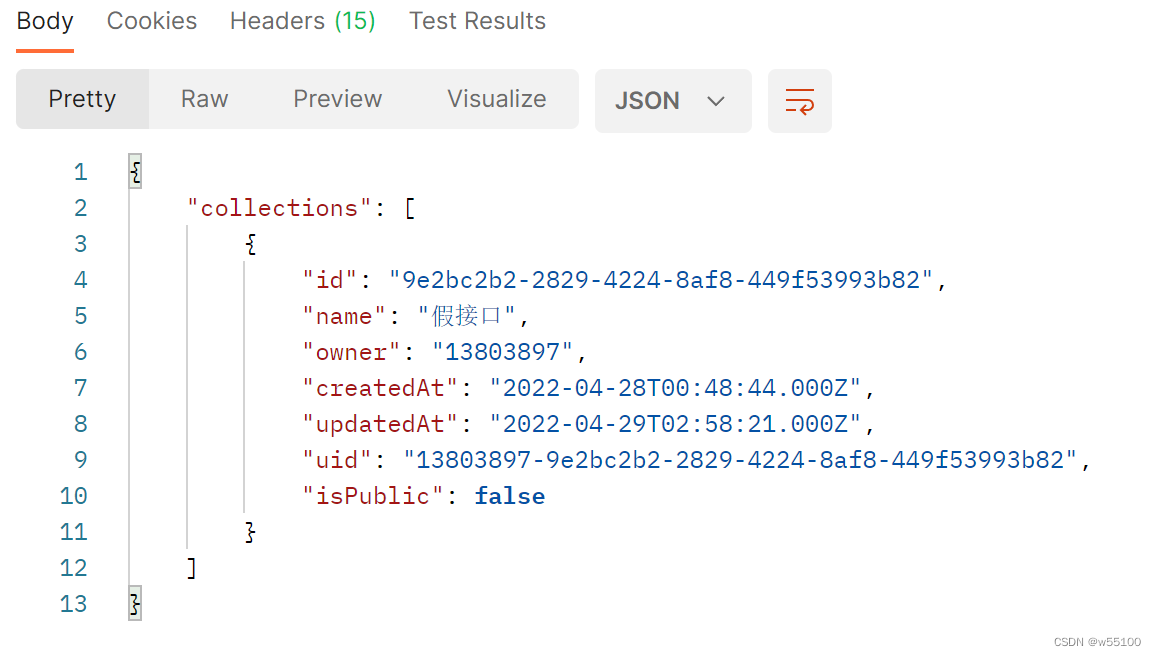
之后把uid,拼接到url后面
https://api.getpostman.com/collections/13803897-9e2bc2b2-2829-4224-8af8-449f53993b82
再请求一次
这一步返回的是当前mock server下的所有配置信息.
可以看到的是,每个request作为对象存放在 "item"数组中.
request下有一个属性"response"数组.
每个example作为对象存放在其中
在response中能为每个example找到唯一"id".
{
"collection": {
"info": {
"_postman_id": "9e2bc2b2-2829-4224-8af8-449f53993b82",
"name": "假接口",
"schema": "https://schema.getpostman.com/json/collection/v2.1.0/collection.json"
},
"item": [
{
"name": "New Request",
"id": "4eb688f1-7e0b-4c82-8708-3523eadc2f25",
"protocolProfileBehavior": {
"disableBodyPruning": true
},
"request": {
"method": "POST",
"header": [],
"body": {
"mode": "raw",
"raw": ""
},
"url": {
"raw": "{{url}}/login",
"host": [
"{{url}}"
],
"path": [
"login"
]
}
},
"response": [
{
"id": "428746aa-b59a-4785-a04b-be667a9528e7",
"name": "Default",
"originalRequest": {
"method": "POST",
"header": [
{
"key": "Content-Type",
"name": "Content-Type",
"value": "application/javascript",
"type": "text"
}
],
"body": {
"mode": "raw",
"raw": "",
"options": {
"raw": {
"language": "javascript"
}
}
},
"url": {
"raw": "{{url}}/login",
"host": [
"{{url}}"
],
"path": [
"login"
],
"query": [
{
"key": "name",
"value": "{{name}}",
"disabled": true
},
{
"key": "password",
"value": "{{password}}",
"disabled": true
}
]
}
},
"code": 200,
"_postman_previewlanguage": null,
"header": null,
"cookie": [],
"responseTime": null,
"body": "{\"id\":\"11\",\"name\":\"abc\",\"token\":\"postlogin\"}"
},
{
"id": "f012d8fb-9622-4544-b0cf-05b1fbfee298",
"name": "example2",
"originalRequest": {
"method": "GET",
"header": [],
"body": {
"mode": "raw",
"raw": ""
},
"url": {
"raw": "{{url}}/login",
"host": [
"{{url}}"
],
"path": [
"login"
]
}
},
"_postman_previewlanguage": null,
"header": null,
"cookie": [],
"responseTime": null,
"body": "{\"id\":\"22\",\"name\":\"abc\",\"token\":\"getlogin\"}"
}
]
},
{
"name": "/get",
"id": "7b7d5f1f-75cf-453f-8309-b277bf715d9e",
"protocolProfileBehavior": {
"disableBodyPruning": true
},
"request": {
"method": "GET",
"header": [],
"body": {
"mode": "raw",
"raw": ""
},
"url": {
"raw": "{{url}}/get",
"host": [
"{{url}}"
],
"path": [
"get"
]
}
},
"response": [
{
"id": "81501999-3d8a-44af-aa66-8e008bffb714",
"name": "Default",
"originalRequest": {
"method": "GET",
"header": [],
"url": {
"raw": "{{url}}/get",
"host": [
"{{url}}"
],
"path": [
"get"
]
}
},
"code": 200,
"_postman_previewlanguage": null,
"header": null,
"cookie": [],
"responseTime": null,
"body": "{ id=1,name='user2', token = 'abcdefg2'}"
}
]
},
{
"name": "/user",
"id": "f8e05f82-91cc-41e6-9bdc-e914585d696e",
"protocolProfileBehavior": {
"disableBodyPruning": true
},
"request": {
"method": "GET",
"header": [],
"url": {
"raw": "{{url}}/user/{{userID}}",
"host": [
"{{url}}"
],
"path": [
"user",
"{{userID}}"
],
"query": [
{
"key": "id",
"value": null,
"type": "text",
"disabled": true
}
]
}
},
"response": [
{
"id": "af2743bd-2a3d-43cd-9ad5-775c11f67000",
"name": "Default",
"originalRequest": {
"method": "GET",
"header": [],
"url": {
"raw": "{{url}}/user/{{userID}}",
"host": [
"{{url}}"
],
"path": [
"user",
"{{userID}}"
],
"query": [
{
"key": "id",
"value": null,
"type": "text",
"disabled": true
}
]
}
},
"_postman_previewlanguage": null,
"header": null,
"cookie": [],
"responseTime": null,
"body": "{\r\n \"id\": \"{{userID}}\",\r\n \"roleID\": \"01\" \r\n}"
}
]
},
{
"name": "/role",
"id": "4d8b2c42-f3fd-4737-9329-6ed345021b8a",
"protocolProfileBehavior": {
"disableBodyPruning": true
},
"request": {
"method": "GET",
"header": [],
"url": {
"raw": "{{url}}/role/{{roleID}}",
"host": [
"{{url}}"
],
"path": [
"role",
"{{roleID}}"
]
}
},
"response": [
{
"id": "0891e08d-0aa0-4075-a63c-782c1f310fa5",
"name": "/role",
"originalRequest": {
"method": "GET",
"header": [],
"url": {
"raw": "{{url}}/role/{{roleID}}",
"host": [
"{{url}}"
],
"path": [
"role",
"{{roleID}}"
]
}
},
"_postman_previewlanguage": null,
"header": null,
"cookie": [],
"responseTime": null,
"body": "{\r\n \"roleID\":\"{{roleID}}\",\r\n \"userMenus\":\"uerMenus\"\r\n}"
}
]
}
]
}
}
在headers中设置
x-mock-response-name 或者
x-mock-response-id
即可对应到我们需要的example.
相当于绕过匹配规则,显式指定返回哪条example的response.
参考https://learning.postman.com/docs/designing-and-developing-your-api/mocking-data/mock-with-api/
